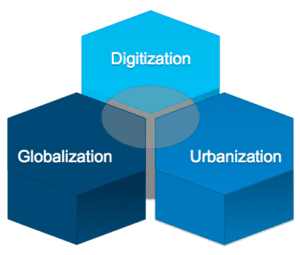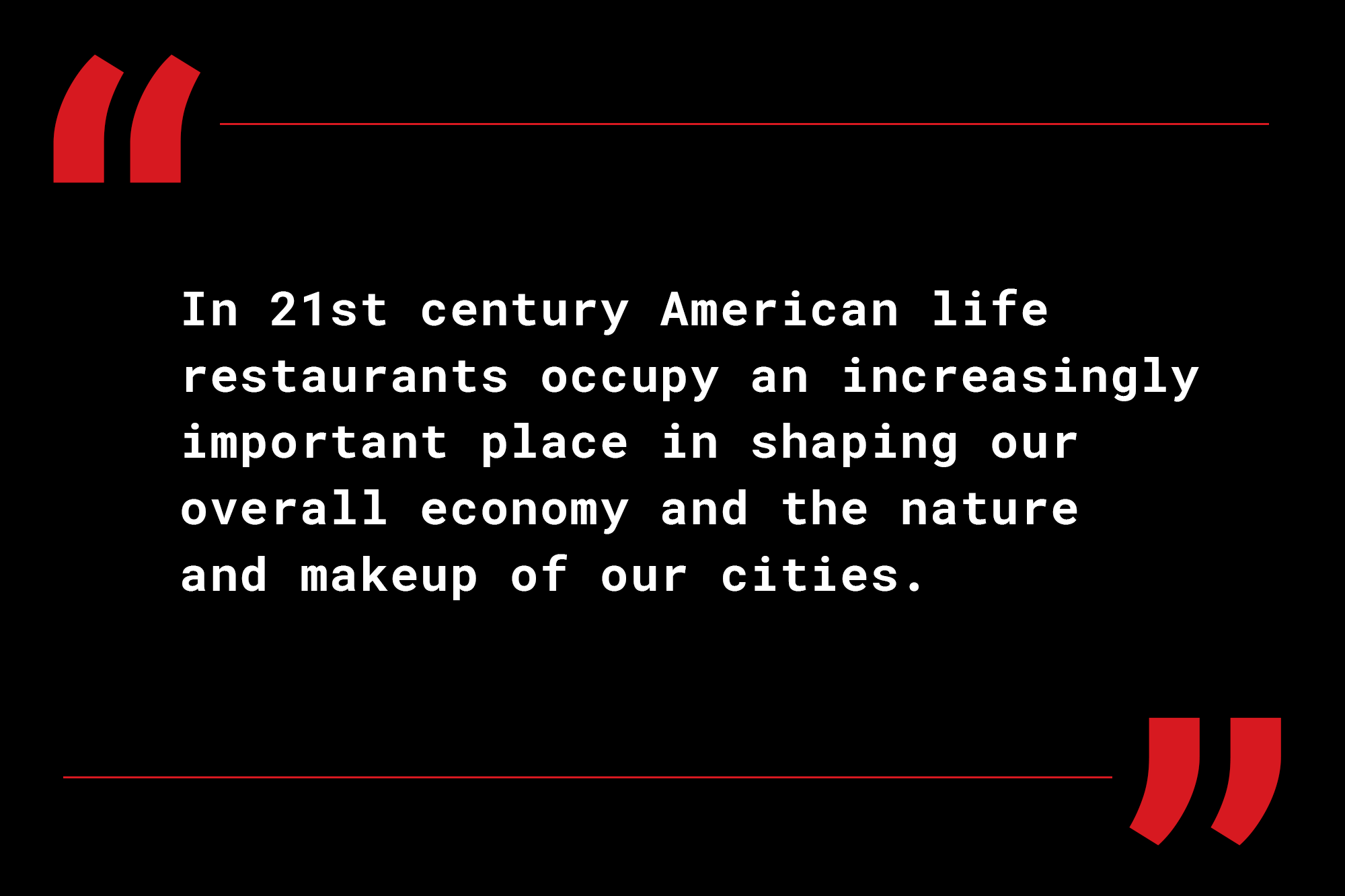Why the Restaurant Industry is the Most Important Industry in Today’s America
Originally posted on Medium.com
January 18, 2015 (And still very applicable)
By Eli Feldman
2015. Is this the year of the restaurant? Not in terms ‘cool new openings’ but in recognizing and achieving potential impact on the country as a whole.
Restaurants have always played an essential role in the business, social, intellectual and artistic life of a thriving society. Think of the cafes of Paris in the 20’s; the three martini lunches of the 50’s and 60’s; we’ve sketched world changing ideas and planned revolutions in restaurants. Elvis’ first Las Vegas contract was written on a restaurant tablecloth.
The major events of life, personal and professional, are celebrated in restaurants. Acquaintances become friends around a table in the safe and controlled environment of a restaurant. Individuals become lovers across a restaurant table, sometimes.
Restaurants are more important than ever. At the tail end of 2014 the influential restaurant blog, Eater, published a round-up of the 60+ restaurants that opened in Boston just this past fall. The writer covered everything from Five Guys, a rapidly expanding quick service burger joint, to Cafe Artscience, a hybrid restaurant/lab/gallery space in Cambridge.
At the end of 2014 The Boston Globe also published a series of articles indicative of the growing importance of restaurants. It was an entire series of articles about the restaurant industry and the subtext can be summed up by this sentence in the final article:
Restaurants today lie at the heart of 21st-century American life. These employers aren’t headed overseas; for the foreseeable future, millions of Americans will wait tables, cook food, or wash dishes for their livelihoods.
The unaddressed question in both pieces is the same: WHY? Why did more restaurants open this fall? Why are restaurants at the heart of 21st century American life? Why are restaurants more relevant now than they have been at any other time in history?
In a nutshell: Urbanization, Digitization and Globalization. We’re all getting pretty familiar with these terms. These are the three dynamic and interactive forces reshaping the nature of our world at the atomic, subatomic and galactic levels. You can’t see a force. You can see the results all around you every day.

Beyond the basic purpose of restaurants to provide food and drink, restaurants have, historically, fulfilled a human need for connection and shaped social relations. In 21st century American life restaurants occupy an increasingly important place in shaping our overall economy and the nature and makeup of our cities.
Urbanization
82% of Americans now live in cities, almost double what it was 100 years ago.
Geoffrey West, a theoretical physicist who has done fascinating work on the scientific model of cities, believes that cities deliver value to inhabitants by facilitating human interaction. “If you ask people why they move to the city, they always give the same reasons,” West says. “They’ve come to get a job or follow their friends or to be at the center of a scene. That’s why we pay the high rent. Cities are all about the people…”
As more people move to cities, living spaces are getting smaller and that high rent is getting stratospheric. In San Francisco and New York, officials are considering overturning laws that set a floor of 400sf for apartment size; sometimes to as low as 200sf. Living affordably in many cities means living with tiny kitchenettes and without dining or living room space. West’s ‘facilitation of human interactions’ happens in restaurants with greater and greater frequency. Restaurants are the shared kitchens and dining rooms of densely populated cities.
Digitization
You can’t eat megabytes of data or go out to eat online.
We may be in a digital age but restaurants operate in an analog world. The digital revolution has not disrupted the industry as it has film, music, retail, etc. Technological advancement has been slow and incremental. Even the most impactful technologies have done little to alter the standard operating procedure of restaurants or the guest experience. Why?
Since we learned to harness fire almost 2 million years ago, existence has been centered on the hearth. Harvard primatologist Richard Wrangham argues that everything that defines our species- anatomically, biologically, socially- can be traced back to cooking food. Communion around food is at the core of religion, family, relationships and almost all of societies pillars. “It’s part of who we are and affects us in every way you can imagine” Wrangham states.
Wrangham takes the evolutionary biologists long view but we’re not so different from our ancestors. We go out for reasons far beyond sustenance and biology. We are seeking connection, edification, and validation when we go out to eat. If anything, the more of our lives we live online, the more we crave the things the dining table provides.
Although the restaurant industry itself remains unchanged by digital advancement, the industry is hugely impacted by the disruptions digitization has brought to other industries. We’ll see later how the dominance of Amazon in online retail has changed the landscape for restaurant entrepreneurship.
Globalization
“These employers aren’t headed overseas”
Think of your favorite neighborhood restaurant. Now imagine you heard they were doing reservations out of India, prepping in the Midwest and serving at their current location. That would be odd, right? Well most industries work this way.
To understand how the restaurant industry is unique in a globalized world, it’s helpful to imagine your neighborhood spot as comprised of two components: a manufacturing facility-the kitchen, and a sales and marketing space-the dining room. The last 60–70 years have seen the geographic uncoupling of manufacturing and sales. For most industries it became economically indefensible to build and sell things in the same location. We’ve grown accustomed to the formula ‘Make things on cheap land with cheap labor and then sell them where people actually live’. It’s this rule, and the technological advancements that have made it possible, that has driven many jobs overseas.
This formula, however, does not work for 95% of restaurant operations. Sure, there is some processing of foods that happens upstream in the supply chain but for most restaurants raw product arrives in the morning, gets prepped during the day and sold in the evening. To do otherwise often comes at the expense of quality and a more discerning guest has a lower tolerance for this sacrifice. Restaurant work is nearly impossible to offshore or outsource meaning it is one of our last, truly durable American industries.
****
The convergence of these forces and the industry’s unique durability in the face of them is why restaurants are at the heart of 21st Century American life.
A healthy, thriving restaurant industry is not only critically important to the fabric of society through obvious stakeholders- the owners, employees and guests- but to an entire network of groups who may not have historically thought of themselves as stakeholders.
Seldom before have the interests of all of the stakeholders converged at such a pivotal juncture for the restaurant industry and America’s cities. Restaurants are woven into city planning, neighborhood development, and real estate unlike any other time in history. The industry impacts nearly 10%, or $1.6 Trillion, of the entire US GDP. To restate Richard Wrangham ‘Restaurants are now part of who we are and affect us in every way you can imagine’.

***
Our Cities and Neighborhoods
So, why did over 60 restaurants open this fall and why did Eater write about it?
Restaurants have always been the leading edge of reshaping neighborhoods. Tribeca Grill, Montrachet and Nobu redefined Tribeca, Roberta’s pushed the envelope of desirable Brooklyn, Eastern Standard resurrected Kenmore Square for many people in Boston.
Our cities and neighborhoods depend on restaurants more in an urbanized and digitized America. In an urbanized America, people dine more outside the home. In a digitized America, people crave the social experience of dining.
City governments are focused on neighborhood development and placemaking because it’s well understood that a vibrant streetscape with pedestrians, retail, and restaurants are keys to great neighborhoods. With this in mind, city planning boards greenlight new development contingent upon mixed use and ground floor retail. Over the past 20 years the entire world of retail has changed.
The digital revolution has brought about a massive migration of retail to online. In practical terms, a developer who is contractually committed to ground floor retail has fewer options for those spaces than ever before. Even 20 years ago that 3000–6000 square foot retail space could have been any number of things- bookstore, shoe store, record store, etc. Not likely in the age of Amazon, Zappos and iTunes. Ground floor retail is becoming increasingly synonymous with restaurants.
In Boston one need only look at the Fort Point/Seaport and Kendall Square neighborhoods to see this happening in real time. Both are essentially experiments in neighborhood building almost exclusively through restaurants.
Employment, the Economy and Economic Mobility
….for the foreseeable future, millions of Americans will wait tables, cook food, or wash dishes for their livelihoods.
We used to make things in cities and in doing so created millions of jobs. We’ve done less and less of this over the past 75 years. Manufacturing is cheaper to do elsewhere and globalization has extended this to mean the entire globe for many industries. Digitization has decreased the number of people required to deliver the same or greater production. Over the past 5 years there has been constant talk of the ‘jobless recovery’ and digitization and globalization are the elephants in the room.
Our economy and employment depend more on restaurants in a digitized and globalized America.
In a digitized America, many industries achieve the same productivity with significantly less employees. In a globalized America, jobs are often created far from where products or services are consumed.
Restaurants are the last bastion of urban manufacturing and, as such, create a massive number of jobs. The industry currently employs 10% of the entire US workforce and this number continues to rise. The National Restaurant Association estimates that nearly 15 million people will work in the industry by 2024.
As a massive employer, restaurants can also address problems of economic mobility. The industry’s jobs are accessible across economic strata and the barriers to entry around training and education are low in comparison to other fields.
Yes, many restaurant jobs are not good jobs, many are low paying, offer little in terms of benefits, developmental path or job security. We now have models across all segments of the industry that show profitability does not require exploitation. Personal, professional, and financial growth can be achieved from any starting point in the industry. Sadly, this is not yet the rule but given the trajectory of employment in other industries it is critical that it become more the norm rather than the anomaly.
Ok, so what do we do with this information…?
Good question! It’s time to elevate the dialogue around the importance of the restaurant industry to our economy and society. In order for the industry to effectively carry the weight that will be required in the coming decades, there are real and complex problems that must be addressed and solved. Here are some key areas to get the conversation going:
– The Economic Model of Restaurants: It is increasingly difficult if not broken. Many operators and entire segments of the industry struggle to achieve even 5% profitability.
– The Work/Life Balance: There is little room for balance and many of the best people leave the industry because we have not found a way to accommodate family cycles.
– The Tip System: It’s failing everyone- guest, owner, manager, employee.
– Job Visibility: The best jobs in the industry are not on the radar of the people who need them most. There are very few conscientious, thoughtful restaurants in neighborhoods with high unemployment so how might someone living there see opportunities beyond fast food?
– Better Technology Tools: We need better tools to solve real problems in the industry around cost management, revenue & yield management, education, training and workforce development. These tools have to work in the context of restaurant work- rarely in front of a computer, multilingual, and time strapped.
– Cost of Education: Formal culinary and hospitality education is too expensive by 10–20x.
– Capital Requirements and Cost of Failure: These are too high. We need new, nimble, and cheap ways to test restaurant ideas and new funding models.
These are very big challenges, but like any challenge, they all create opportunities. To address the challenges and capitalize on the opportunities we need to start new conversations. Consider this article an effort to do just that. Urbanization, digitization and globalization have aligned the long term interests of the industry with that of society and the economy as a whole. If 2015 is truly to be the year of the restaurant, the best minds of the industry must seek out partners across groups with something at stake in the success of restaurants. These groups are growing and there are willing partners. If you’re interested in being part of the discussion, send us your thoughts @three_princes or info@3princesconsulting.com.




